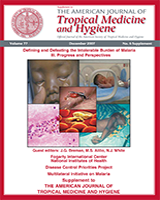| Madagascar Highlands |
| 1949–1960 |
IRS with DDT and chloroquine treatment of infected individuals 86
|
1954: disappearance of Anopheles funestus; eradication nearly achieved in 1960 84
|
|
| Post-1960 |
Spraying with DDT limited to 3 foci; closure of treatment centers 86
|
1980: 3-fold increase in the number of malaria cases 86Reappearance of An. funestus in mid-1970s 84Severe epidemic (1985–1990) with 40,000 deaths 85
|
|
| 1993–1997 |
IRS with DDT in highland communities at 1,000–1,500 m in elevation covering 2.3 million inhabitants 911996: Establishment of malaria surveillance system to record malaria cases at the 536 health centers in the region 87
|
28% decrease in the incidence of malaria in sprayed areas only, with no change in incidence in unsprayed areas 870.8% and 4.5% prevalence of malaria parasites in schoolchildren in sprayed and unsprayed areas, respectively, at 1,000–1,500 m 85Prevalence of Plasmodium positive schoolchildren was 23.8% and 0.4% before and after OPID, respectively, at 1,000–1,500 m 91
|
| Eritrea |
| 2000–2004 |
|
|
| South Africa: KwaZulu- Natal |
| 1946–1996 |
IRS with DDT began in 1946 with complete coverage of malarial regions by 1958 21
|
600 reported cases of malaria in the Province in 1991–1992 89
|
|
| 1996–1999 |
1996: Synthetic pyrethroids were substituted for DDT 21
|
1998–1999: reinvasion of An. funestus and doubling of malaria cases 562000: 40,700 reported cases of malaria 79
|
|
| 2000 |
2001: Artemether-lumefantrine became first-line therapy for un-complicated malaria 92
|
About 90% reduction of malaria cases after reintroduction (2000–2004) compared with before (1996–1999) 902001: 17,500 reported cases; 2002: 3,500 reported cases 89
|
